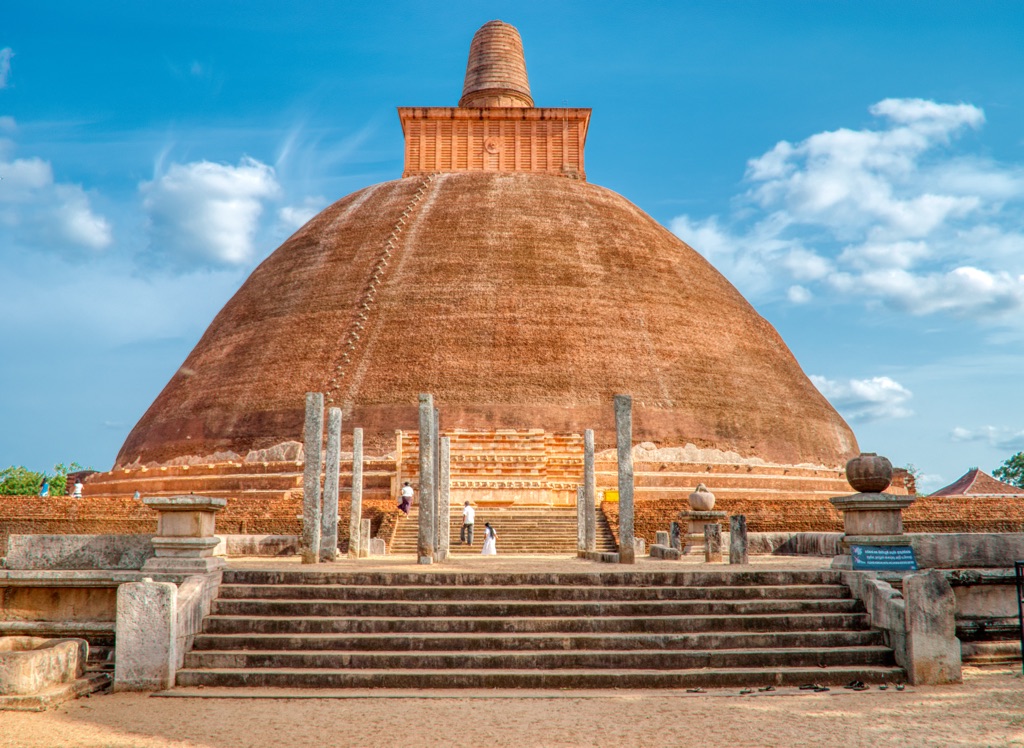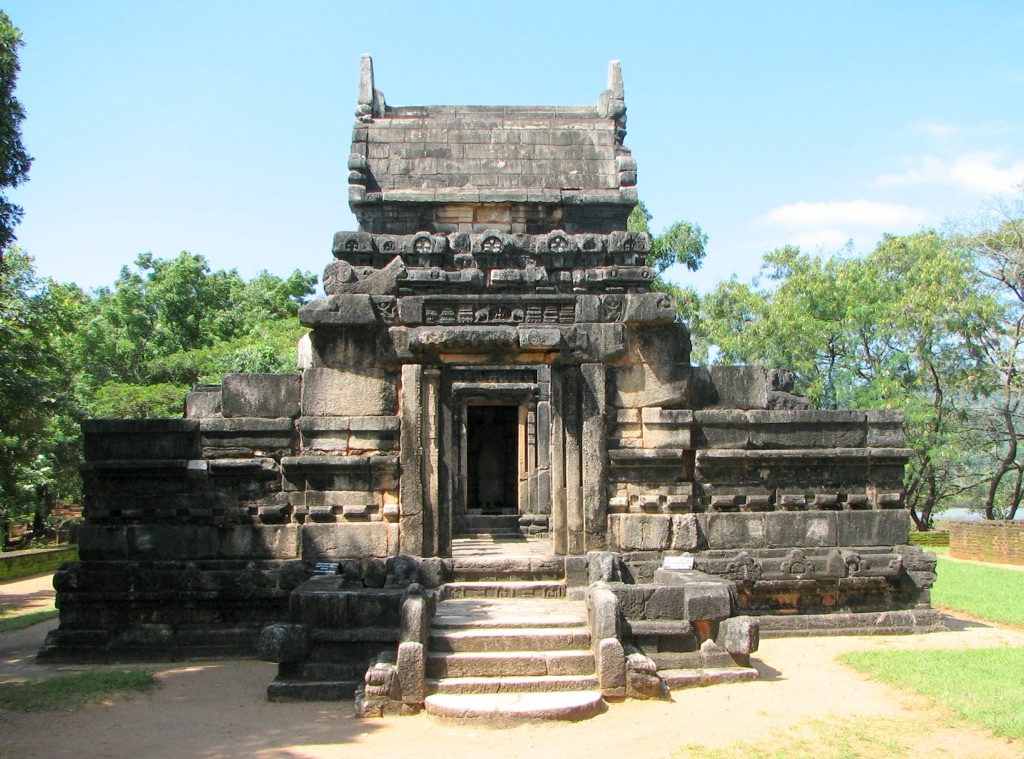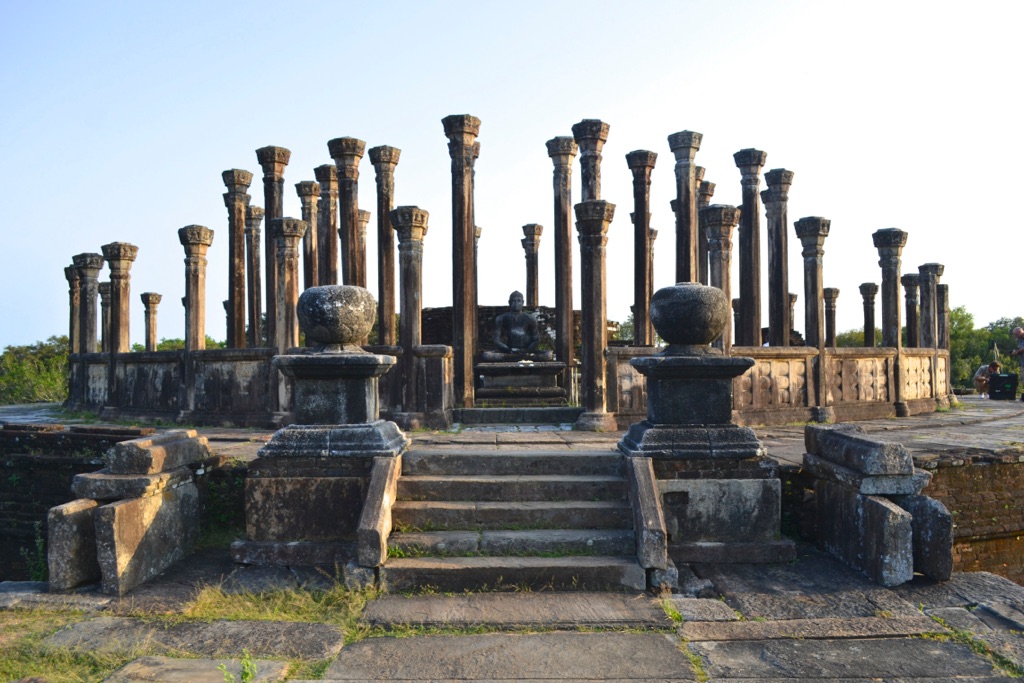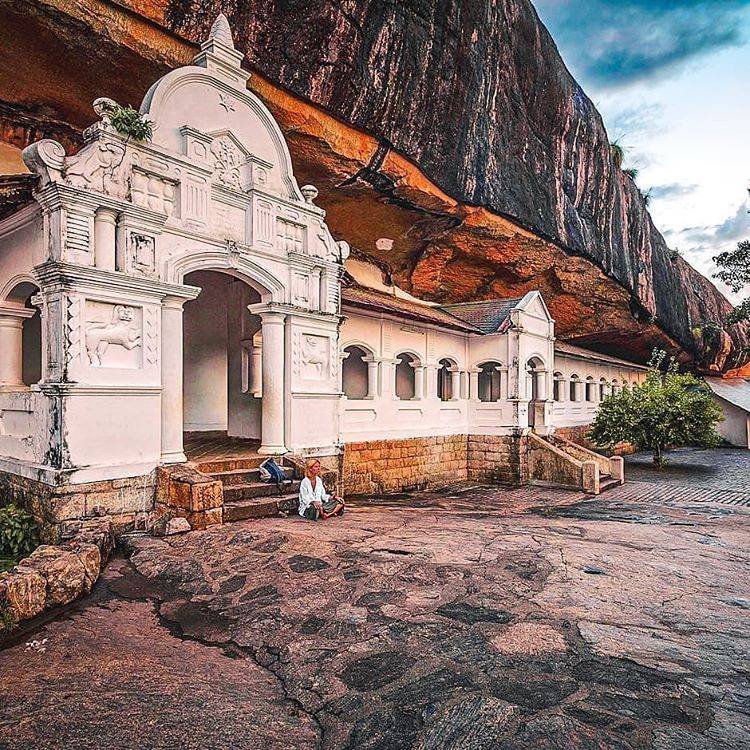The Dambulla Cave Temple, also known as the Golden Temple of Dambulla, is a World Heritage Site in Sri Lanka. This sacred pilgrimage site has been a place of worship for over 22 centuries. The complex consists of five caves, which contain over 150 images of the Buddha, making it one of the most extensive and well-preserved cave temple complexes in the world. The murals covering the walls and ceilings add to the site’s historical and artistic significance, depicting the Buddha’s life and important events in the history of Sri Lankan kings.
Anuradhapura Kingdom

The Anuradhapura Kingdom, which thrived from the 4th century BCE to the 11th century CE, stands as a significant chapter in the history of Sri Lanka, showcasing a period rich in cultural, architectural, and political development. Established by King Pandukabhaya, Anuradhapura was not just the first major kingdom of the island but also its longest-serving capital. This era is marked by the introduction and flourishing of Buddhism, which played a pivotal role in shaping the socio-political and cultural landscape of the kingdom. The city of Anuradhapura, at its zenith, was a bustling metropolis, adorned with magnificent stupas, beautifully sculpted statues, and vast reservoirs, reflecting the advanced engineering and architectural prowess of its people.
The Anuradhapura Kingdom is renowned for its significant contributions to Buddhist culture, most notably through the arrival of Mahinda, the son of the Indian Emperor Ashoka, who is credited with introducing Buddhism to the island. This event is considered a cornerstone in Sri Lankan history, leading to the establishment of the Buddhist Sangha and the construction of the Mahavihara, the first monastery, which became the heart of Theravada Buddhism in Sri Lanka. The kingdom’s rulers, such as Devanampiya Tissa, who was a contemporary of Mahinda, embraced Buddhism and supported its spread through the construction of stupas, temples, and monasteries, thereby embedding Buddhist principles deeply into the societal fabric.

The architectural achievements of the Anuradhapura Kingdom are among its most enduring legacies. The construction of massive stupas, such as the Ruwanwelisaya and the Jetavanaramaya, the latter being one of the tallest ancient structures in the world, showcases the advanced engineering skills and the aesthetic sensibilities of the era. Additionally, the kingdom’s engineers excelled in hydraulic technology, as evidenced by the intricate network of reservoirs and canals built to support agriculture and sustain the city’s population. These feats of engineering not only highlight the kingdom’s technological advancements but also its commitment to a sustainable relationship with the environment.
The decline of the Anuradhapura Kingdom began in the late 10th century, culminating in its abandonment in 993 CE following invasions by South Indian Chola forces. Despite its fall, the legacy of Anuradhapura lives on, preserved in the ruins that continue to attract scholars and tourists alike, offering a glimpse into the grandeur of ancient Sri Lanka. The kingdom’s contributions to Buddhist culture, its architectural marvels, and its sophisticated systems of water management are reflective of a civilization that was ahead of its time in many respects. Today, the ancient city of Anuradhapura is a UNESCO World Heritage Site, celebrated for its historical significance and enduring cultural heritage.
Anuradhapura Kingdom Archaeological sites and Artifacts
FAQ: Exploring the Ancient Anuradhapura Kingdom
What was the downfall of the Anuradhapura Kingdom?
The downfall of the Anuradhapura Kingdom, a beacon of ancient civilization in Sri Lanka, was not the result of a single event but a series of invasions, internal strife, and economic challenges. The most significant blow came from the repeated invasions by South Indian Chola and Pandya dynasties in the late 10th and early 11th centuries. These invasions weakened the kingdom’s military and economic infrastructure. Coupled with internal political instability and the shifting of trade routes, these factors gradually eroded the power and influence of Anuradhapura, leading to its eventual abandonment in favor of Polonnaruwa as the new capital in the late 11th century.
How many kings were in the Anuradhapura Kingdom?
The Anuradhapura Kingdom, spanning over a millennium, was ruled by more than 100 kings. This long line of monarchs began with King Pandukabhaya, who is traditionally dated to have established the kingdom in 437 BCE, and ended with King Mahinda V, whose reign ended in 1017 CE when the Chola dynasty from South India invaded and took control of the kingdom. The exact number of kings varies in historical records, but the Mahavamsa, a chronicle of Sri Lankan history, provides detailed accounts of many of these rulers and their contributions to the kingdom’s development.
How old is the Anuradhapura Kingdom?
The Anuradhapura Kingdom is believed to have been established in 437 BCE by King Pandukabhaya, making it over 2,450 years old. This ancient kingdom flourished as the political and religious capital of Sri Lanka for over a millennium, until its decline in the 11th century CE. Its long history is marked by significant achievements in irrigation, architecture, and Buddhism, making it one of the oldest continuously inhabited cities in the world and a testament to ancient Sri Lankan civilization.
What was the timeline of the Anuradhapura Kingdom?
The timeline of the Anuradhapura Kingdom spans from its establishment in 437 BCE to its decline in the 11th century CE. Here’s a brief overview:
– 437 BCE: Foundation by King Pandukabhaya.
– 3rd Century BCE: Introduction of Buddhism during the reign of King Devanampiya Tissa, marking a significant cultural and religious transformation.
– 1st Century BCE to 1st Century CE: Construction of large reservoirs and irrigation systems, including the Ruwanwelisaya Stupa under King Dutugemunu.
– 4th to 5th Century CE: The kingdom experiences a golden age under rulers like King Mahasena and King Dhatusena, with advancements in agriculture, trade, and architecture.
– 10th Century CE: Beginning of South Indian Chola invasions, leading to periods of occupation and instability.
– 1017 CE: The kingdom falls to the Chola Empire, marking the end of Anuradhapura as the capital of Sri Lanka.
This timeline encapsulates the rise, flourishing, and eventual decline of one of South Asia’s most significant ancient civilizations, highlighting its enduring legacy in Sri Lankan culture and history.

Medirigiriya Vatadage
The Medirigiriya Vatadage is a historical structure located in the Polonnaruwa District of Sri Lanka. It stands as a testament to the country’s ancient architectural prowess and Buddhist heritage. This circular relic house, known as a Vatadage, was designed to hold the sacred tooth relic of the Buddha. It is renowned for its intricate stone…

Nalanda Gedige
Nalanda Gedige is an ancient and enigmatic edifice located in the heart of Sri Lanka. It is a remarkable fusion of Hindu and Buddhist architecture, which has puzzled historians and archaeologists alike. The structure is often admired for its intricate carvings and the synthesis of cultural elements. Nalanda Gedige’s exact origins are shrouded in mystery,…

Jetavanaramaya
The Jetavanaramaya is a significant historical and archaeological site located in Anuradhapura, Sri Lanka. It stands as a testament to the country’s ancient engineering prowess and religious devotion. This stupa, or Buddhist reliquary monument, was once among the tallest structures of the ancient world. It was built by King Mahasena of Anuradhapura (273–301 AD) and…

